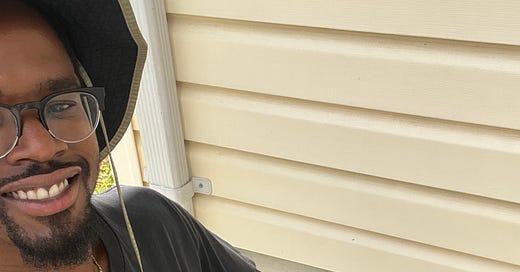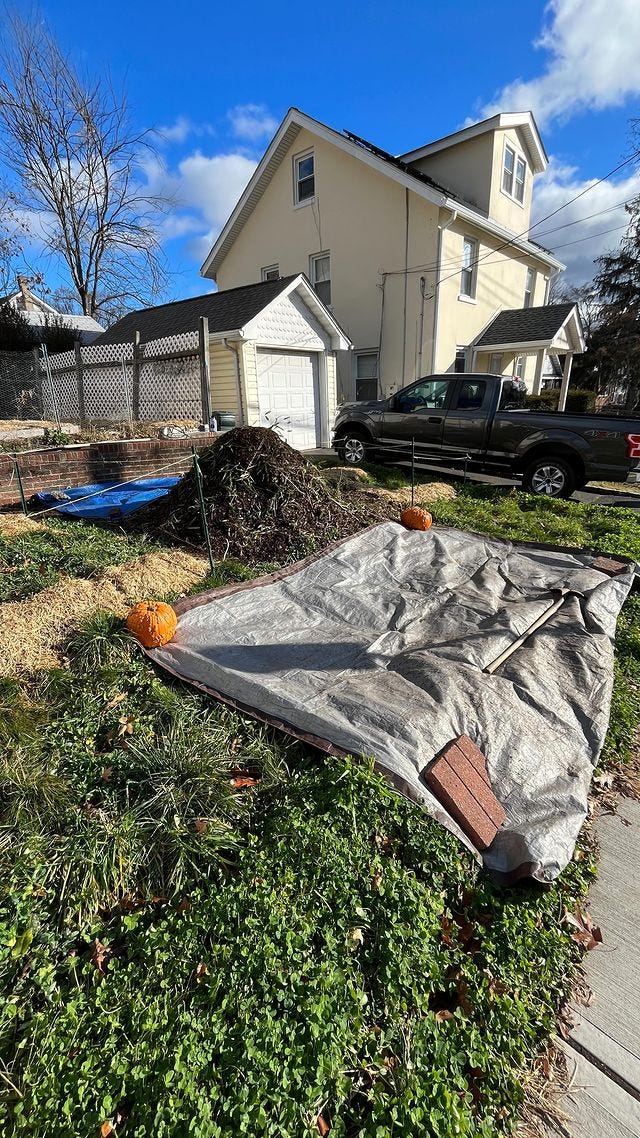A handful of helping microbes with Dujon and Green Glow Gardens
On aiming for a balanced soil and a good life.
A few months ago, farmer (and friend to me) Jahsh Banks put me onto one of his friends, a guy named Dujon Blondel, who runs a regenerative lawn care company called Green Glow Gardens out of New Jersey.
Dujon does it all:
He makes composts and compost teas, ferments his own bokashi grain, brews his own inoculants, and raises worms. He makes friends everywhere he goes. Importantly, he is always learning things and then sharing them with others. If you follow him on Instagram, you’ll find easy-to-follow instructional videos on everything from composting to plant nurturing and regenerative garden care. I also love that he’s chipping away at America’s lawn problem, working with people in his community to slowly convert their practices of care from a reliance on synthetics and pesticides to a deeper understanding of how soil works and the principle of balance.
It’s really inspiring to hang out, even just through the internet, with somebody who is doing so much and so immersed in their practice. So, of course I wanted to reach out to him and ask to have a conversation about it all.
Thankfully, he said yes.
Can you tell us a little about yourself?
My name is Dujon. I’m a practitioner of regenerative agriculture, from Korean natural farming to organic farming. I also use Elaine Ingham’s soil food web compost-making methodology, which I was taught through a few of my mentors. I combine all the practices into my farming and gardening.
Oh, cool. How do you use Elaine’s program?
Right now, I mainly focus on using the soil food web program to make compost. I am using that compost to make compost extract and compost teas, which I apply for my client’s on their lawns and gardens. I currently run Green Glow Gardens, which is a lawn and garden fertilization company where we use all organic inputs, mainly focusing on Elaine’s methodology.
The videos here show what I do. The soil food web methodology has taught me to create compost using a thermophilic process. To create thermophilic compost, there are certain ratios that we put together in the materials we use.
When I say material, I mean the greens, the manures, and by using that specific ratio along with the temperatures that I’ve been taught to mark out and follow, I receive a certain fungal-to-bacteria ratio, which is very beneficial for the soil. The compost I’ve been taught to create is usually more fungally-dominant and it’s loaded with nematodes, bacteria, lactic-acid bacteria, and a whole bunch of other beneficial microbes that heal the soil.
So here is a video that shows me inoculating my compost pile with compost extract. This is the compost extract that I use to tend to my yard and feed to my garden, as well as take care of my client’s properties.
Oh cool, can you talk more about what it means to have a fungally-dominant compost? I know that it’s so widely coveted by composters.
Well, I would say that I don’t personally subscribe to having a fungally-dominant soil. I subscribe to having a balanced soil. The main reason that I use the soil food web practices to make compost is ease of access for me to make the extract and apply it. I don’t have to brew anything or use any aerators. I can just put it in a bag, massage and water it, and extract the microbes out of that bag.
I would say the most important part is using and sourcing good quality ingredients. Not all compost is made the same and some compost tends to be made with harmful materials or materials that are not very clean. Like, there are bad microbes around and too many of them can create an imbalance in your soil, but if you have a balance of good bacteria and good fungi in the soil, that allows for life to thrive. Ideally, that is what I’m looking for. That is what I like to do when I approach soil or tend to these spaces. Create balanced ecosystems with both good bacteria and good fungi.
Right now, when I build my compost, I source my material locally. I source wood chips from the recycling center. I have a friend who has a bamboo patch, so I go to his property and harvest bamboo leaves for my greens. I also have another friend who has a few dairy cattle. I use her manure. I know that her manure and her cattle are pasture-raised, with no antibiotics. There is also a woman who has a chicken farm. She raises chickens for eggs and I go to her house and get her manure, as well, to use that to make my compost.
Last year, for the second compost pile that I made, I also used food scraps that I fermented with bokashi grain from our house. That compost pile was used on the property, at the beginning of the year, to feed the soil and the garden.
I also have a worm bin next to my compost pile where I take those fermented foods scraps and I use those to feed the worms. Throughout the season, I’ve been emptying out the worm bin to make worm casting extracts. I intend on using those castings in the yard once I harvest the garlic I planted.
What I really like about your process is that you don’t just compost, you utilize every element of your components. It’s really whole-systems thinking.
Do you have to educate your clients on why to compost? Or do they come to you because they already know and want compost?
Well, right now there’s a lot of education happening. Thank God I am still in the early phases of the business, where I still have time to prove my point. I work other jobs to help me pool my finances and continue to invest in both the business and my education.
Seeing as I’m in New Jersey, a lot of the information that I’m delivering to people is totally brand new. They’re so used to chemical agriculture or these mow-and-blow companies that come by and just sprinkle synthetics on the soil and they see a little pop of green and they go about their business.
Or the other companies that have lawn treatment systems, where they come in and spray synthetic fertilizers on the soil, as well as chemicals to kill weeds such as clover… which, you know, I have to explain to my clients that clover is actually pretty beneficial to their soil.
What are some differences you’ve seen in people’s lawns that you work with? Any good before-and-after stories?
Well, for one, as a cannabis grower and somebody who uses cannabis on the daily…I can tell the difference between plants that are grown in a living soil system versus plants that are grown using synthetics.
For example, when me and my friends left the large-scale farm we were on, we just happened to fall into places where they let us use regenerative methods to grow cannabis. I also have had a space in my backyard, like when I was living in Arcata. I had about six raised beds where I practiced living soil and was able to grow cannabis using compost teas that I was brewing at the house. And, you know, though my plants may not have yielded the biggest yield, the profile of the cannabis was insane.
What do you mean by “profile”?
When I say the profile, I mean the way the flower smells, how well it stores, the high, the taste of that flower. The first time I started growing regeneratively in my backyard, I grew Purple Punch. Since that day Purple Punch has been my favorite strain. I know people complain, “Ah, Purple Punch doesn’t get you stoned.” But when I grew my Purple Punch, it brought me back to elementary school, when I would eat Fred Flintstone vitamins. Even now, I think about it, when I just think about smoking or think about that Purple Punch plant, I can distinctively taste it.
Can you tell me a little about your mentors and how you learned in this space?
Working with soil really showed me that I am a kinesthetic learner.
I have to touch things in order for me to understand. So, for example, I learned to grow cannabis with people who let me test the plants. During my learnings, I also spent a lot of time listening to podcasts that spoke on investing in your education. So I did that, too. Then, once I started making a bit of money during the cannabis gold rush in California, I realized how valuable my education was.
There’s only so much money can do for you in the sense of material possessions, but in the sense of investing in education, I was able to take my money and invest in a regenerative cannabis conference in northern California in 2019, and from there I ended up meeting Chris Trump. He’s a really well-known Korean farming practitioner.
At that time, after I took the class with Chris, that’s when the kinesthetic part of my learning really started to take place. Because during his courses, he allows us to touch the IMO piles, which is an inoculant that we use in Korean natural farming. We’re allowed to taste the ferments, smell the ferments, put our hands in them, and feel their texture.
I just want to keep learning.
You know, after I started to understand the Korean natural farming system, I wanted to learn how to make compost. I tried once using some kelp, some wood chips, and a few other things, but the pile didn’t even heat up. It just so happened that Keisha and Casey of Catalyst BioAmendments were hosting a class in Grass Valley, and Keisha has been a mentor of mine since that time period.
What do you want the future to look like? Where do you want to go from here?
In the future, I’d like to be focused on scaling my business and getting more lawns converted over to an organic system.
I understand not everybody wants a vegetable garden in their yards. A lot of people enjoy cutting their grass. Because I understand how to deliver a handful of microbes to the soil to create a healthy ecosystem for things to grow in, though, I’m going to push that part of the business extremely hard.
I would like to be podcasting and doing my own podcast in the future, living on a homestead, and owning realty for my family. I would like to be spending time studying and hanging out with my kids. I don’t have any children right now, but ideally I’m building this business and this lifestyle for me to be able to to hang out with my family, whether that’s my partner, future partner, my Mom, my Dad, my kids, their friends, and whatever that looks like.
The purpose of Green Glow is to help me cultivate freedom and to deliver a helping handful of microbes to as many people as I possibly can.









Catching up on a couple posts I missed! I love following Dujon, after seeing what he's up to I tend to put my phone down to go spend time in my compost practice 🤎 he's a very active practitioner which inspires me to stay engaged. Love the concluding sentiment too - life & business can really be quite simple if we can resist overcomplicating it.